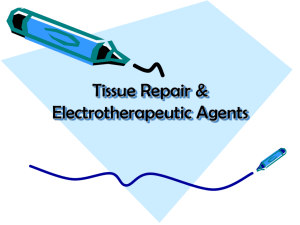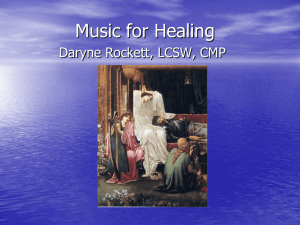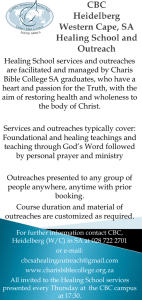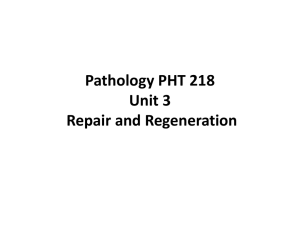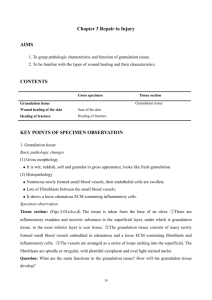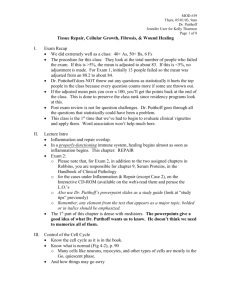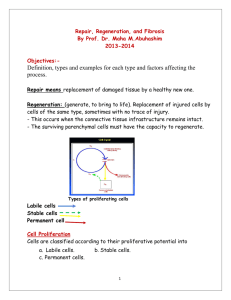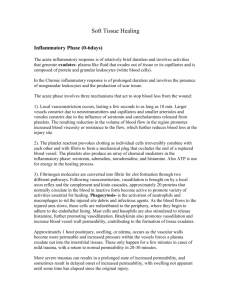Ch4
advertisement
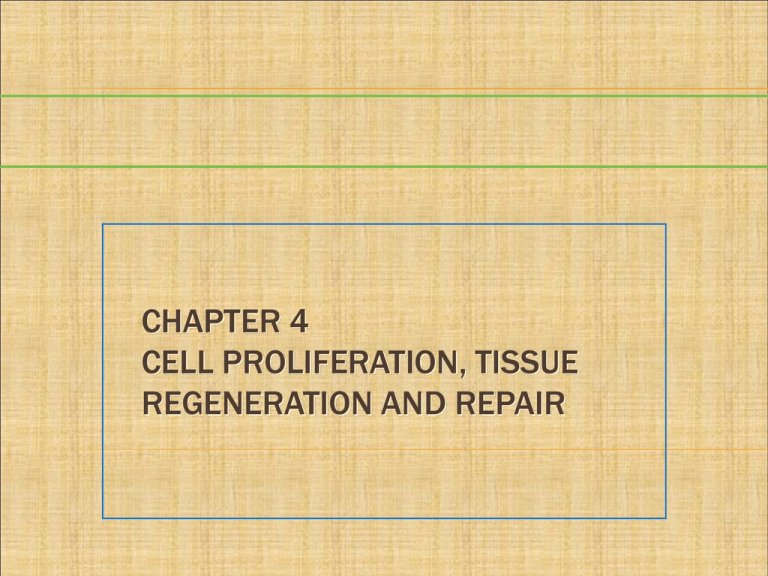
CHAPTER 4 CELL PROLIFERATION, TISSUE REGENERATION AND REPAIR PRE LECTURE QUIZ TRUE/FALSE T 1. Stem cells are undifferentiated cells that have the capacity to generate multiple cell types. F 2. DNA synthesis takes place during the G0 phase of the cell cycle. T 3. The inflammatory phase of wound healing prepares the wound environment for the healing process. T 4. The formation of granulation tissue involves the creation of new capillaries. F 5. A large surface wound is likely to heal by the process of primary intention. FILL-IN-THE-BLANK growth keloids matrix Scar Stable 1. _____________ tissues contain cells that normally stop dividing when growth ceases. 2. The extracellular _____________ is secreted locally and assembles into a network of spaces surrounding tissue cells during the process of tissue regeneration. 3. When regeneration cannot occur, healing by replacement with a connective tissue occurs, a process that terminates in ______________ formation. 4. The term _____________ factor is generally applied to small hormonelike proteins that increase cell size and cell division. 5. An abnormality in healing by scar tissue repair is the formation of _____________, which are benign tumorlike masses caused by excess production of scar tissue. CELL PROLIFERATION AND TISSUE REGENERATION Parenchymal tissue Stromal tissue -The working part - The binding part CELL PROLIFERATION VERSUS DIFFERENTIATION Cell proliferation-process of increasing cell numbers by mitotic division Cell Differentiation-process whereby a cell becomes more specialized in terms of structure and function THE CELL CYCLE 4 distinct phases PROLIFERATIVE CAPACITY OF TISSUES Varies with tissue and cell type 3 divisions of body tissues: a. Continuously doubling b. Stable c. Permanent tissues STEM CELLS Incompletely differentiated throughout life 3 Properties: a. Self-renewal b. Asymmetric replication c. Differential potential (potency) INFLUENCE OF GROWTH FACTORS Small hormonelike proteins that increase cell size and cell division PDGF, FGF, TGF, and EGF EXTRACELLULAR MATRIX AND CELL-MATRIX INTERACTIONS ECM is secreted locally and assembles a network of spaces surrounding tissue cells Components of ECM: a. Fibrous structural proteins b. Water-hydrated gels c. Adhesive glycoproteins COMPONENTS OF THE ECM HEALING BY CONNECTIVE TISSUE REPAIR PHASES OF REPAIR Angiogenesis and ingrowth of granulation tissue Emigration of fibroblasts and deposition of extracellur matrix Maturation and reorganization of the fibrous tissue (remodeling) Usually begins within 24 hours of injury; evidenced by the migration of fibroblasts and the induction of fibroblast and epithelial cell proliferation ANGIOGENESIS AND INGROWTH OF GRANULATION TISSUE MATURATION AND REMODELING OF THE FIBROUS TISSUE CUTANEOUS WOUND HEALING The transition from granulation to scar tissue shifts in the modification and remodeling of the ECM HEALING BY PRIMARY AND SECONDARY INTENTION Primary intention – sutured surgical incision Secondary intentionlarger wounds which have a greater loss of tissue and contamination PHASES OF HEALING Inflammatory Phase Proliferative Phase Maturational or Remodeling KELOIDS FACTORS THAT AFFECT WOUND HEALING Nutritional Status Blood Flow and Oxygen Delivery Age NUTRITIONAL STATUS Local and systemic factors influence wound healing Vitamin C and A play an essential role in the healing process Vitamin C is needed for collagen synthesis Vitamin A functions in stimulating and supporting epitheilial BLOOD FLOW AND OXYGEN DELIVERY For healing to occur, wounds must have adequate blood flow to supply the necessary nutriients and to remove waste, local toxins, bacteria and other debris. WOUND HEALING IN THE ELDERLY Age-related changes: A decrease in dermal thickness A decline in collagen content Loss of elasticity Elderly are more vulnerable to chronic wounds, such as pressure, diabetic, and ischemic ulcers as compared to younger persons
